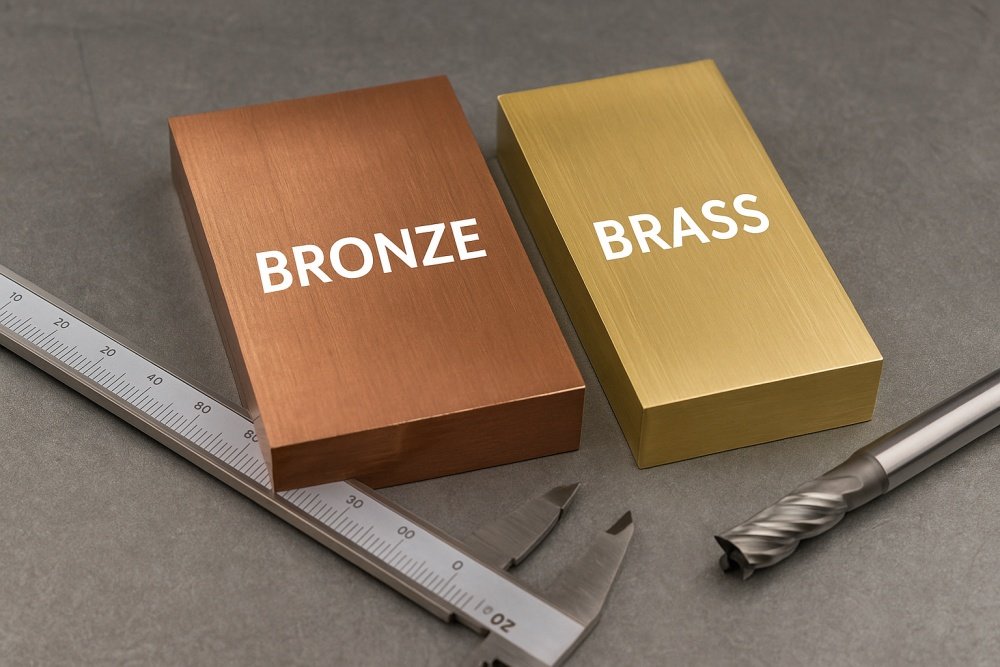In the fast-paced world of manufacturing, getting the details right can turn a good project into a great one. Whether you’re an engineer sourcing parts for a new prototype or a shop owner looking to optimize your processes, knowing your materials inside out is key. One common puzzle that pops up time and again is how to tell difference between bronze and brass—two metals that look similar but behave quite differently under the tool. This isn’t just trivia; it’s essential knowledge for anyone involved in CNC machining, where the wrong choice can lead to costly mistakes or subpar performance. In this in-depth guide, we’ll break down how to spot those differences, explore advanced techniques like using a hydraulic metal bending machine and large diameter turning, and see how these play out in real-world applications such as machining for the oil and gas industry or crafting medical device machined plastics. Stick around, and you’ll walk away with practical tips to apply in your next job.
How to Tell Difference Between Bronze and Brass: The Basics of Material Identification
Let’s start with the fundamentals because, honestly, I’ve seen too many folks mix up bronze and brass, leading to headaches down the line. Both are copper-based alloys, but their compositions set them apart in ways that matter for machining. Bronze typically mixes copper with tin, sometimes adding elements like aluminum or manganese for extra strength. Brass, on the other hand, blends copper with zinc, making it more malleable and often brighter in appearance.
So, how do you tell the difference between bronze and brass without a lab? First, check the color. Fresh brass has a yellowish-gold hue, almost like a shiny penny, while bronze leans toward a reddish-brown tone, similar to aged copper. Over time, bronze develops a greenish patina from oxidation, whereas brass tends to tarnish to a duller yellow. If you’re hands-on, try the sound test—tap them with a metal object. Brass rings with a higher, sharper pitch, like a bell, while bronze gives a deeper, more muted thud.
Weight and hardness offer more clues. Bronze is denser and harder, resisting scratches better, which makes it ideal for bearings or marine hardware where durability counts. Brass is softer and easier to work with, perfect for fittings or decorative pieces. For a definitive check, use a magnet: neither is magnetic, but if it sticks, you’ve got something else entirely. Or, dip a small sample in nitric acid—brass will fizz and release fumes, while bronze reacts more slowly.
Why bother with all this? In CNC machining, selecting the right material affects everything from tool wear to final tolerances. Misidentifying them could mean your hydraulic metal bending machine struggles with unexpected brittleness, or your large diameter turning setup faces uneven cuts. Even when branching into non-metals, like medical device machined plastics, understanding alloy differences sharpens your overall material savvy. I’ve worked on projects where a simple swap from brass to bronze extended part life by 30%, so mastering how to tell difference between bronze and brass pays off big time.

Precision Machining Techniques: Hydraulic Metal Bending Machines and Large Diameter Turning
Once you’ve nailed material identification, the real fun begins with shaping those metals into functional parts. Enter the hydraulic metal bending machine—a powerhouse tool that’s revolutionized how we handle curves and angles in CNC setups. This machine uses hydraulic pressure to bend metal tubes or sheets with pinpoint accuracy, minimizing distortion and ensuring consistent results. It’s especially handy for alloys like bronze and brass, where maintaining structural integrity during forming is crucial.
Picture this: you’re bending a bronze pipe for a high-pressure system. The hydraulic metal bending machine applies even force across the material, preventing cracks that might occur with manual methods. Controls allow for programmable bends, so you can replicate complex shapes across batches. Paired with CNC integration, it handles radii from tight curves to sweeping arcs, all while keeping tolerances under 0.5 degrees.
But bending is just one piece; for cylindrical components, large diameter turning steps up. This technique involves rotating large workpieces on a lathe to shave off material, creating precise outer diameters up to several feet wide. It’s a go-to for oversized shafts or hubs made from brass or bronze, where standard lathes fall short. The process demands robust tooling to counter vibrations, often using carbide inserts for clean cuts.
In practice, combining a hydraulic metal bending machine with large diameter turning creates seamless workflows. For instance, you might bend a brass tube first, then turn its ends for perfect fittings. This synergy reduces waste and speeds production, especially in demanding fields. And don’t forget: knowing how to tell difference between bronze and brass helps here too—if you’re turning bronze, expect more heat buildup and adjust feeds accordingly.
I’ve seen shops cut setup times in half by mastering these tools. If you’re dealing with medical device machined plastics, similar principles apply, though with softer feeds to avoid melting. Overall, these techniques elevate your CNC game, turning challenging jobs into routine successes.
Industry Applications: Machining for Oil and Gas, Plus Medical Device Machined Plastics
Now, let’s see how these concepts play out in the real world, starting with machining for the oil and gas industry. This sector demands parts that withstand extreme pressures, corrosion, and temperatures, making bronze a star player for valves and fittings due to its toughness. Brass shines in instrumentation where malleability aids intricate designs.
In oil rigs or pipelines, a hydraulic metal bending machine might form bronze tubing for hydraulic lines, while large diameter turning crafts massive flanges for secure connections. Machining for the oil and gas industry often involves custom alloys, so accurately telling the difference between bronze and brass prevents failures—like a brass part corroding in salty environments where bronze would thrive. Case in point: a recent project I followed involved turning large-diameter bronze bushings for drill heads, boosting efficiency by 20% through better wear resistance.
Shifting gears to healthcare, medical device machined plastics take center stage. Plastics like PEEK or polycarbonate are machined for implants, surgical tools, or housings, offering biocompatibility and lightweight advantages over metals. Here, precision is life-or-death—think CNC-milled plastic components for pacemakers or endoscopic devices.
While metals require hydraulic presses, medical device machined plastics favor high-speed milling to avoid burrs. But material knowledge crosses over: just as you’d differentiate bronze from brass, you compare plastic grades for sterility or flexibility. In hybrid devices, like a brass-reinforced plastic catheter, large diameter turning might finish the metal core before plastic overmolding.
Machining for the oil and gas industry and medical device machined plastics both highlight versatility in CNC. Oil pros prioritize durability, while med-tech focuses on precision and safety. By integrating tools like large diameter turning, manufacturers bridge these worlds, delivering reliable parts across industries.
Wrapping It Up: Putting Knowledge into Action
Pulling it all together, mastering how to tell difference between bronze and brass is your foundation, opening doors to advanced techniques and applications. From deploying a hydraulic metal bending machine for curved components to leveraging large diameter turning for hefty parts, these skills ensure your projects run smoothly. And whether it’s machining for the oil and gas industry with rugged alloys or crafting medical device machined plastics for delicate tools, the principles remain the same: choose wisely, machine precisely.
As an ISO-certified factory, we’ve built a reputation on turning these insights into tangible results. If you’re tackling a tricky part or need advice on materials, drop us a line—we’re here to help elevate your next build. What’s your biggest material challenge? Share in the comments, and let’s keep the conversation going.
Get Your CNC Quote Now
I wish your next production run deserves precision and efficiency. Contact us to GET FREE QUOTE today!
Dongguan Huade Precision Manufacturing Co., Ltd.
Address: 1st Floor, Building 2, No.5, Jiangcheng West 1st Street, Gaobu Town, Dongguan City,Guangdong Province, China.
Email: sales@hdproto.com
Website: https://hdproto.com
